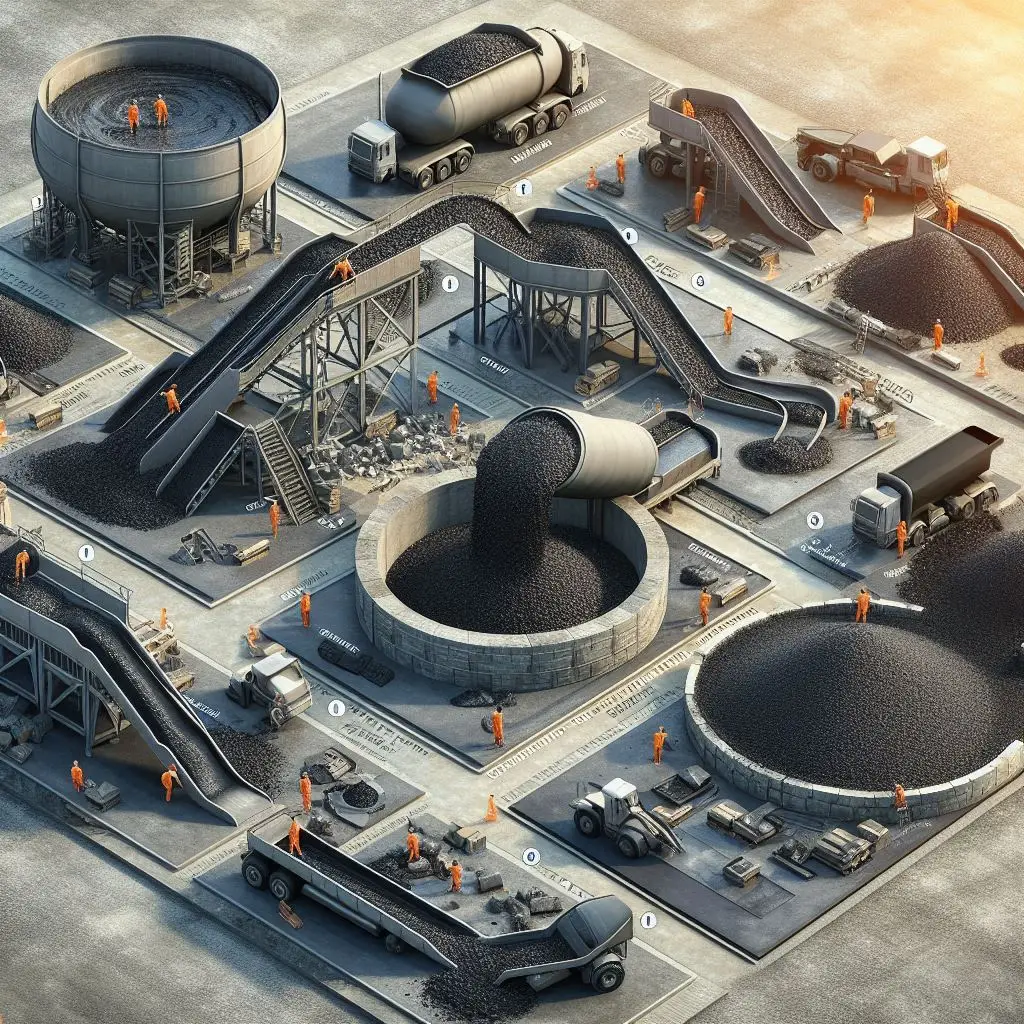
Bitumen and Asphalt production process
Introduction
This article explores the step-by-step production processes of bitumen and asphalt, highlighting the critical stages involved in their manufacture.
Bitumen and asphalt are essential materials in road construction and infrastructure projects worldwide. While bitumen is a viscous, black petroleum-based substance used as a binder, asphalt is a mixture of bitumen and aggregates, forming a durable surface for roads, parking lots, and pavements. The production of both materials involves specialized techniques that ensure high performance, durability, and environmental sustainability.
Bitumen Production Process
Bitumen is derived from crude oil or natural oil sands and undergoes a series of refining and upgrading processes to achieve the desired properties for construction applications. Below are the key stages of bitumen production:
1. Extraction
Bitumen is sourced from two primary methods:
- Crude Oil Refining: Bitumen is extracted from crude oil in refineries through a distillation process.
- Oil Sands Mining: In regions with natural bitumen deposits, such as Canada, open-pit mining or in-situ extraction techniques are used to separate bitumen from sand and clay.
2. Separation
Once extracted, the raw bitumen undergoes a separation process to remove unwanted materials like sand, water, and impurities. In the case of oil sands, this is done using hot water and chemical treatments to help bitumen rise to the surface, allowing easy collection.
3. Upgrading
Bitumen is naturally heavy and contains impurities such as sulfur, nitrogen, and heavy metals. The upgrading process includes:
- Hydrocracking and Hydrotreating: These methods help improve bitumen quality by breaking down large hydrocarbon molecules and removing impurities.
- Vacuum Distillation: This technique separates bitumen from lighter fractions, ensuring a consistent final product.
4. Blending
Bitumen from different sources may be blended to achieve specific performance characteristics, such as improved flexibility, durability, and resistance to temperature variations. Additives like polymers may also be introduced to enhance its properties.
5. Storage
After refining and blending, bitumen is stored in heated tanks to maintain its viscosity and prevent solidification. These tanks are designed to withstand high temperatures, ensuring that the material remains in liquid form until transportation.
6. Transportation
Bitumen is transported using specialized tanker trucks, railcars, or pipelines. Since bitumen needs to remain in a semi-liquid state during transit, heating systems are often used to maintain the required temperature.
Asphalt Production Process
Asphalt is a carefully formulated blend of aggregates and bitumen, designed to provide long-lasting and high-performance pavement surfaces. The following are the critical steps in asphalt production:
1. Aggregate Selection
The quality of aggregates plays a crucial role in asphalt performance. Common aggregates include crushed stone, gravel, and sand. These materials are carefully selected based on their size, shape, and strength to ensure durability and resistance to wear and tear.
2. Drying and Heating
Before mixing, the aggregates are dried in a rotary drum to remove moisture and prevent improper binding with bitumen. The drying process also ensures that the aggregates reach the correct temperature for optimal asphalt production.
3. Bitumen Addition
Once the aggregates are heated, bitumen is introduced in precise proportions. Bitumen acts as a binding agent, coating the aggregate particles and giving asphalt its adhesive properties. The ratio of bitumen to aggregates varies depending on the intended application and road conditions.
4. Mixing
The heated aggregates and bitumen are thoroughly mixed in specialized asphalt mixing plants. This ensures an even distribution of bitumen, creating a cohesive and high-quality asphalt mixture.
- Batch Mixing: A controlled method where ingredients are mixed in batches for precise composition.
- Continuous Mixing: A streamlined process where ingredients are continuously blended for high-volume production.
5. Storage and Transportation
The freshly mixed asphalt is stored in insulated silos or tanks to maintain its temperature before transportation. Asphalt is then delivered to construction sites in specialized heated trucks to ensure it remains workable during application.
6. Paving and Compaction
At the construction site, the hot asphalt mixture is spread using pavers and then compacted with rollers to achieve the desired thickness and density. Proper compaction enhances the asphalt’s durability and resistance to traffic loads.
Conclusion
The production of bitumen and asphalt involves meticulous processes to ensure quality, durability, and efficiency. From the extraction and upgrading of bitumen to the careful selection and mixing of aggregates in asphalt production, each step plays a vital role in infrastructure development. Advancements in technology continue to improve production methods, making bitumen and asphalt more environmentally friendly and sustainable.
As the demand for high-quality road materials grows, innovation in production techniques will further enhance their performance and longevity, supporting the development of resilient and long-lasting infrastructure worldwide. The use of recycled materials, improved refining techniques, and energy-efficient processes are helping reduce the carbon footprint associated with bitumen and asphalt production. Governments and industries are increasingly investing in sustainable solutions, ensuring that future road construction projects balance performance with environmental responsibility.
Moreover, continued research and technological advancements in bitumen modification and asphalt formulation will further enhance the durability, weather resistance, and cost-effectiveness of these materials. As a result, cities and transportation networks can benefit from more sustainable, long-lasting, and efficient road surfaces that meet the growing demands of modern infrastructure. This ongoing innovation will play a crucial role in the future of road construction, contributing to the safety and reliability of global transportation networks.

